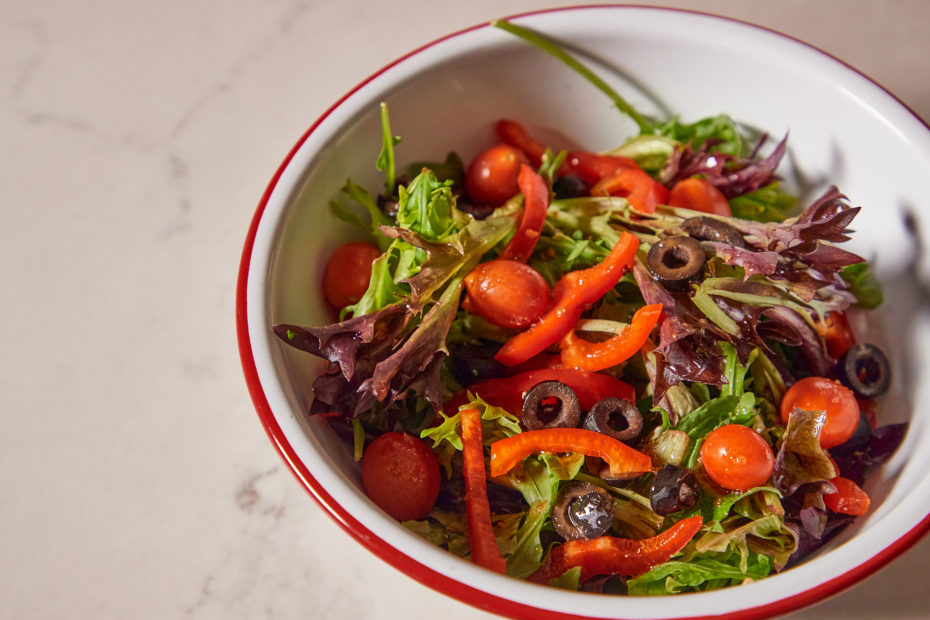Here at Pizzaria Locale, we think simple is best.
For example, salad dressing. Pick up any bottle of salad dressing at your local supermarket and check the ingredients list—you might be amazed at how long it is.
But are all those ingredients really necessary? Are they healthy?
It starts with olive oil
The primary ingredient in most salad dressings is oil; in the United States, soybean oil is most frequently used, although olive, peanut, corn, and sunflower oils may be substituted for one of them, or even the ubiquitous “vegetable oil,” which may be a combination of two or more oils. Stabilizers and thickeners, such as modified food starch, are mixed with the oil.
Understand that these oils are heavily processed, so they may not be the healthiest picks. Many vegetable oils are extracted using a chemical solvent called hexane (made from crude oil!); they’re then heated to remove the hexane, bleached, and deodorized. These oils usually contain a small amount of trans fats from the refining process, and hexane residue is detectable in some oils.
You’ll notice that olive oil isn’t on that list. But at Pizzeria Locale, we use only a blend of extra-virgin olive oil with non-GMO canola oil. Why? We’re glad you asked!
- Olive oil is rich in monounsaturated oleic acid, believed to have many beneficial effects.
- Olive oil is loaded with antioxidants, some of which have powerful biological effects.
- Olive oil contains nutrients that fight inflammation, including oleic acid and the antioxidant oleocanthal. Science has shown that people who consume olive oil have a much lower risk of stroke, the second-biggest killer in developed countries.
- Olive oil has numerous benefits for heart health. It lowers blood pressure, protects “bad” LDL cholesterol particles from oxidation, and improves the function of blood vessels.
What else should people look out for?
If a commercial dressing isn’t labeled organic, there’s a good chance it contains genetically modified organisms (GMOs). According to the United States Department of Agriculture nearly all the corn, soy, and canola crops grown in the United States are genetically modified.
Almost all dressings also contain a long list of additives, some of which you may want to avoid: they include artificial colors, stabilizers, thickeners, gums and emulsifiers, high-fructose corn syrup, and monosodium glutamate (MSG). Commercial salad dressings also frequently contain a lot of water—and while there’s nothing wrong with water, a watered-down dressing may require more sugar and sodium for flavoring.
So what’s in a Pizzeria Locale vinaigrette?
We use just a few great ingredients to make the red wine vinaigrette for our salads. But it occurred to us recently that you might like to try it out at home to season your own signature salads, raw veggies, pasta salads, and more.
What makes a vinaigrette? It’s simple: vinaigrette is made by mixing oil with something acidic (such as vinegar or lemon juice). The mixture can be enhanced with salt, herbs, and/or spices. That’s it. No long list of additives. Good, simple food.
At Pizzeria Locale, we keep it simple: our extra-virgin olive oil blend, red wine vinegar, salt, lemon juice, and oregano. That’s it! We mix them in the right order so you can taste the richness of the olive oil, the mouth-watering acidity of the red wine vinegar, the salt and herbs, and the refreshing lemon.
We’d really love to see you eschew the commercial dressings from the supermarket and make this simple delicious vinaigrette at home—it’s better for you, and it’s easy to do!
Pizzeria Locale red wine vinaigrette recipe
This recipe makes one 12-ounce squeeze bottle of dressing; all you do is add the ingredients to the squeeze bottle in the following order. Make sure the salt dissolves in the vinegar and lemon juice before adding other ingredients, and then shake vigorously:
1/4 cup red wine vinegar
1/8 cup lemon juice
¾ tsp. salt
7/8 cup olive oil
2 tsp. oregano
Enjoy—we know you will!



